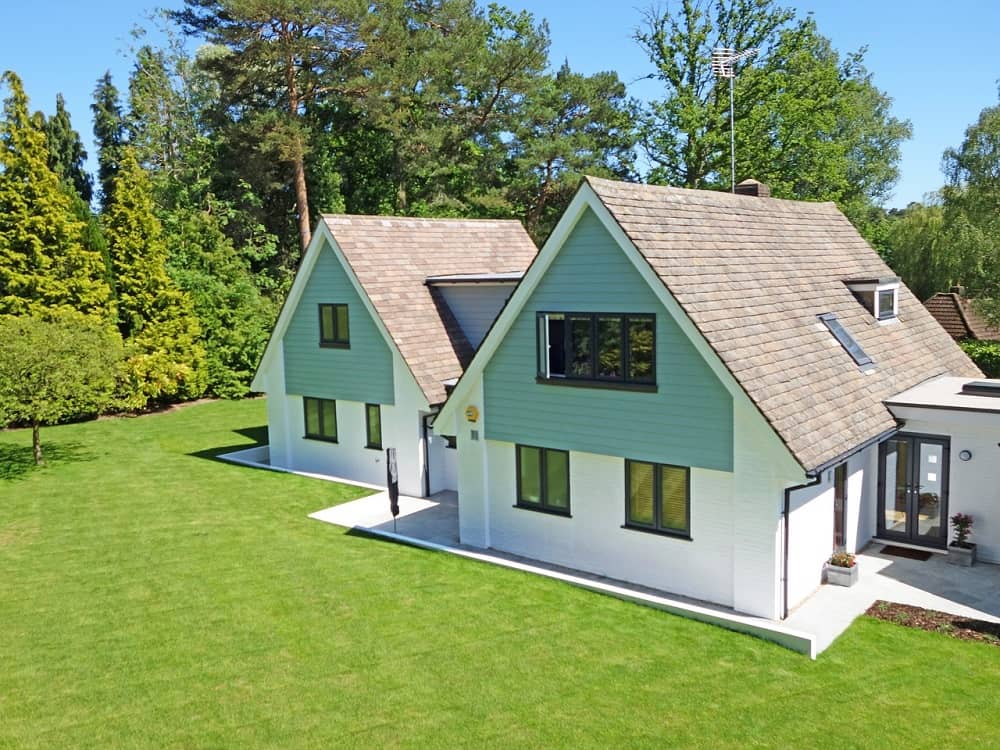It’s no secret that all homeowners want to increase curb appeal and property value. Improving or upgrading your exterior siding is a surefire way to add some immediate curb appeal. However, all siding isn’t created equal. How do you know which exterior siding type is right for your home or budget?Let’s break down five of the most popular types of exterior siding and talk about the pros, the cons, and the cost.

Exterior Siding
Fiber Cement
Fiber cement is a material created by combining cement, wood pulp, other fillers, and water. Fiber cement is known for looking like natural materials while having the strength of concrete. It’s durable, weather-resistant, non-flammable, and resists pests and rodents. It’s low-maintenance and lasts for an average of 50 years.
There are some downsides to fiber cement. It will require expert installation, and you’ll have to re-paint the siding at some point throughout its life. It’s environmentally neutral, and non-recyclable, and its insulation protection is lower than some alternatives. It’s also a heavy siding material, so you’ll have to ensure your structure is sound enough to hold it.
As far as cost goes, fiber cement is costlier than a lot of alternatives. However, it’s shown to be an excellent investment.

Fiber Cement
Metal
Metal siding can be aluminum, zinc, steel, or copper. Aluminum and steel are the most popular, and they both have their distinct advantages and disadvantages. Both types of metal are insect, water, and fire-resistant. They’re also malleable, so they’re exceptionally versatile.
Steel is incredibly durable, and it holds paint color well. Steel is eco-friendly and can endure temperature changes and dangerous weather conditions, like tornadoes. The downsides to steel are that steel does rust, and it doesn’t resist heat very well. It’s also costly.
Aluminum is eco-friendly, low-maintenance, and one of the most cost-effective options on the market. If you’re looking for a budget-friendly siding option, aluminum is a popular choice. The disadvantage is that aluminum damages easily, because it’s a soft metal. It’s also noisy with changing temperatures and wears down over time.
Stone Veneer
Stone veneer siding is a way to have that natural stone look, without the natural stone price tag. It’s generally made from cement, pigments, and polyurethane poured into stone molds. Stone veneer is much lighter and cheaper than natural stone, while providing the look of stone. It’s not porous, so it’s easy to clean and maintain, while resisting water damage. It’s also resistant to fire.
There are also some downsides to stone veneer siding. Builders tend to emphasize the look of the stone veneer, versus the installation efficiency. Installing stone veneer siding is a complex process that’s often underestimated. If incorrectly installed, moisture gets trapped under the siding, and it’s often improperly sealed, which leads to leaks and vent problems. Even if appropriately installed, stone veneer siding will need to be sealed and re-sealed to ensure that it can stand up to wet weather and moisture.
If you’re looking for that natural stone look, stone veneer is a cheaper alternative.
Wood
Many homeowners choose wood for its aesthetic charm. It’s eco-friendly and a decent insulator. Additionally, there’s a wide range of style options. Wood is considered a high-end siding choice, so having your siding redone to wood, can increase your property value quite a bit.
Wood siding, while beautiful, comes with several downsides. It’s costly and tiring to maintain, as wood siding needs to be stained every few years to prevent moisture damage. Wood is very attractive to insects, especially termites. If any part of the wood siding breaks, it will need to be immediately fixed to avoid mold growth. Also, wood siding doesn’t score very high in fire safety ratings.
(It’s worth noting here that wood choice, protectants, and installation quality can all influence these disadvantages, making them much less or non-existent. It truly depends on the wood used, how it was cut, how it was protected, and how it was installed).
Despite its disadvantages, wood remains one of the most expensive siding options, thanks to its natural beauty and charm.
Vinyl
Vinyl is a cost-effective way to achieve long-lasting and durable color on your home’s siding. It’s low-maintenance and is not affected by humidity, moisture, or insects. It can be cast in any color, so vinyl is often used to mimic wood siding. When it comes to choosing whether to go with wood vs vinyl siding, it usually comes to down to cost and benefit analysis.
As far as vinyl’s disadvantages, vinyl is made of PVC plastic resin, so it’s plastic. For a lot of people, that’s an issue, mainly because of plastics association with being cheap. Despite its material, it’s hard to tell the difference between vinyl and the real thing from the curb. It’s not until you get up in front of it that you see the difference. Vinyl is pretty durable, but it can be damaged, and when it’s damaged, it usually required that you replace the entire panels, versus patchwork replacement.
Vinyl is the most cost-effective, budget-conscious option on this list. In fact, around 90% of homes in the United States have vinyl paneling.
Which Exterior Siding is Best?

Exterior Sliding
Ultimately, the best siding choice for you will be based on your personal goals. If you’re looking for the cheapest option, go with vinyl. If you want durability, opt for fiber cement. If you want a combination of durability and flexibility, steel is a great choice. If you’re interested in really hiking your property value, wood or natural stone is the way to go.
The reality is that with the proper installation and maintenance, all of these siding options will enhance your curb appeal and boost your property value. Get a good idea of your budget, maintenance, and investment goals, and choose the siding that best fits the bill.






